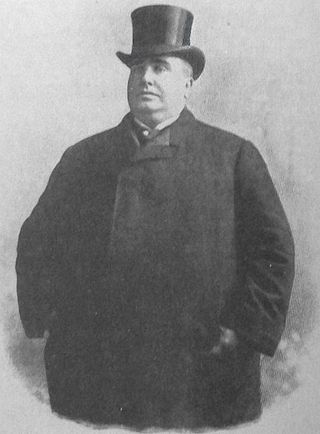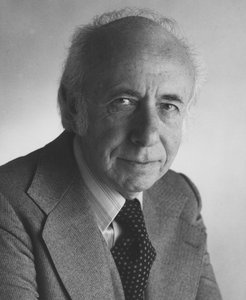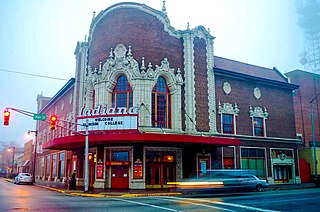Related Research Articles

William James "Count" Basie was an American jazz pianist, organist, bandleader, and composer. In 1935, he formed the Count Basie Orchestra, and in 1936 took them to Chicago for a long engagement and their first recording. He led the group for almost 50 years, creating innovations like the use of two "split" tenor saxophones, emphasizing the rhythm section, riffing with a big band, using arrangers to broaden their sound, and others. Many musicians came to prominence under his direction, including the tenor saxophonists Lester Young and Herschel Evans, the guitarist Freddie Green, trumpeters Buck Clayton and Harry "Sweets" Edison, plunger trombonist Al Grey, and singers Jimmy Rushing, Helen Humes, Thelma Carpenter, and Joe Williams.

Terre Haute is a city in and the county seat of Vigo County, Indiana, United States, about 5 miles (8 km) east of the state's western border with Illinois. As of the 2020 census, the city had a population of 58,389 and its metropolitan area had a population of 168,716.

Claude Thornhill was an American pianist, arranger, composer, and bandleader. He composed the jazz and pop standards "Snowfall" and "I Wish I Had You".

Indiana State University (ISU) is a public university in Terre Haute, Indiana. It was founded in 1865 and offers over 100 undergraduate majors and more than 75 graduate and professional programs. Indiana State is classified among "D/PU: Doctoral/Professional Universities".

Seger Pillot Ellis was an American jazz pianist and vocalist. He also made a few brief film appearances, most notably in collaboration with director Ida Lupino.

Paul Dresser was an American singer, songwriter, and comedic actor of the late nineteenth and early twentieth centuries. Dresser performed in traveling minstrel and medicine-wagon shows and as a vaudeville entertainer for decades, before transitioning to music publishing later in life. His biggest hit, "On the Banks of the Wabash, Far Away" (1897), was the best selling song of its time. Although Dresser had no formal training in music composition, he wrote ballads that had wide appeal, including some of the most popular songs of the era. During a career that spanned nearly two decades, from 1886 to 1906, Dresser composed and published more than 150 songs. Following the success of "Wabash", many newspapers compared Dresser to popular composer Stephen Foster. "On the Banks of the Wabash, Far Away" became the official song of Indiana in 1913. The Paul Dresser Birthplace in Terre Haute is designated as a state shrine and memorial. Dresser was inducted into the Songwriters Hall of Fame in 1970.

Morton Gould was an American composer, conductor, arranger, and pianist.

"On the Banks of the Wabash, Far Away" was among the best-selling songs of the 19th century, earning over $100,000 from sheet-music revenues. Written and composed by American songwriter Paul Dresser, it was published by the Tin Pan Alley firm of Howley, Haviland and Company in October 1897. The lyrics of the ballad reminisce about life near Dresser's childhood home by the Wabash River in Indiana, United States. The song remained popular for decades, and the Indiana General Assembly adopted it as the official state song on March 14, 1913. The song was the basis for a 1923 film of the same title. Its longtime popularity led to the emergence of several lyrical versions, including an 1898 anti-war song and a Swedish version that was a number-one hit.

Pittsburgh Creative and Performing Arts 6–12 (CAPA) is a magnet school located in the Cultural District of Downtown Pittsburgh, Pennsylvania. CAPA is one of four 6th to 12th grade schools in the Pittsburgh Public Schools. It was formed from a merger between CAPA High School and Rogers CAPA Middle School.

Cora "Lovie" Austin was an American Chicago bandleader, session musician, composer, singer, and arranger during the 1920s classic blues era. She and Lil Hardin Armstrong are often ranked as two of the best female jazz blues piano players of the period.

John Gustave Davis was an American actor, singer and trumpeter.
short description=early American ragtime composer

Chicago, Illinois is a major center for music in the midwestern United States where distinctive forms of blues, and house music, a genre of electronic dance music, were developed.
This is a timeline of music in the United States from 1880 to 1919.

Avery Sharpe is an American jazz double-bassist, electric bassist, composer, educator and founder of the artist-owned record label, JKNM Records.

"Wabash Blues", with words by Dave Ringle and music by Fred Meinken, was the first major success for pianist, saxophonist and song composer Isham Jones (1894–1956). Recorded in 1921 by Isham Jones and his Orchestra, this million-seller stayed twelve weeks in the U.S. charts, six at No. 1. Other popular recordings were by Benson Orchestra of Chicago, Dolly Kay, Ted Lewis (1930) and Russ Morgan (1939).
Hannah Sylvester was an American blues singer who performed in the classic female blues style, which was popular during the 1920s. She was billed as "Harlem's Mae West".
Joe Weaver was an American Detroit blues, electric blues and R&B pianist, singer and bandleader. His best known recording was "Baby I Love You So" (1955), and he was a founding member of both the Blue Note Orchestra and the Motor City Rhythm & Blues Pioneers. Over his lengthy but staggered career, Weaver worked with various musicians including the Four Tops, Marvin Gaye, John Lee Hooker, Nathaniel Mayer, the Miracles, Martha Reeves, Nolan Strong & the Diablos, Andre Williams, Nancy Wilson, and Stevie Wonder. In addition, Weaver was a session musician in the early days of Motown Records and played in the house band at Fortune Records. He was a key figure in the 1950s Detroit R&B scene.

The Indiana Theatre is a historic theater in Terre Haute, Indiana, United States. It was added to the National Register of Historic Places on November 13, 1997 and is located in the Wabash Avenue-East Historic District. It opened on January 28, 1922. The theatre was built by Terre Haute resident T. W. Barhydt and was designed by John Eberson. Eberson, who later developed the atmospheric theater style of movie palace, first experimented with atmospheric design elements at the theatre. Eberson stated, "Into this Indiana Theatre I have put my very best efforts and endeavors in the art of designing a modern theatre such as I have often pictured as what I would do were I given a free hand." Through this quote Eberson suggests that the Indiana Theatre embodies the raw beginning of his experiment with a "dream" theater that marked the beginning shift to his atmospheric style.
References
- 1 2 3 web.indstate.edu Wabash Valley Profiles
- 1 2 Hometown with Tom Roznowski Profiles of Hometown Characters: Archived December 22, 2016, at the Wayback Machine
- ↑ John Gates.com Johnnie "Scat" Davis Archived December 1, 2008, at the Wayback Machine
- ↑ terre haute symphony orchestra Reflecting on Seventy-Five Years of the Terre Haute Symphony Orchestra Archived May 17, 2008, at the Wayback Machine
- 1 2 Ace Records Complete Meteor Blues R&b & Gospel Recordings Archived October 13, 2007, at the Wayback Machine
- ↑ Boija.com Meteor singles 1952–57
- ↑ Soulful Kinda Music Duke